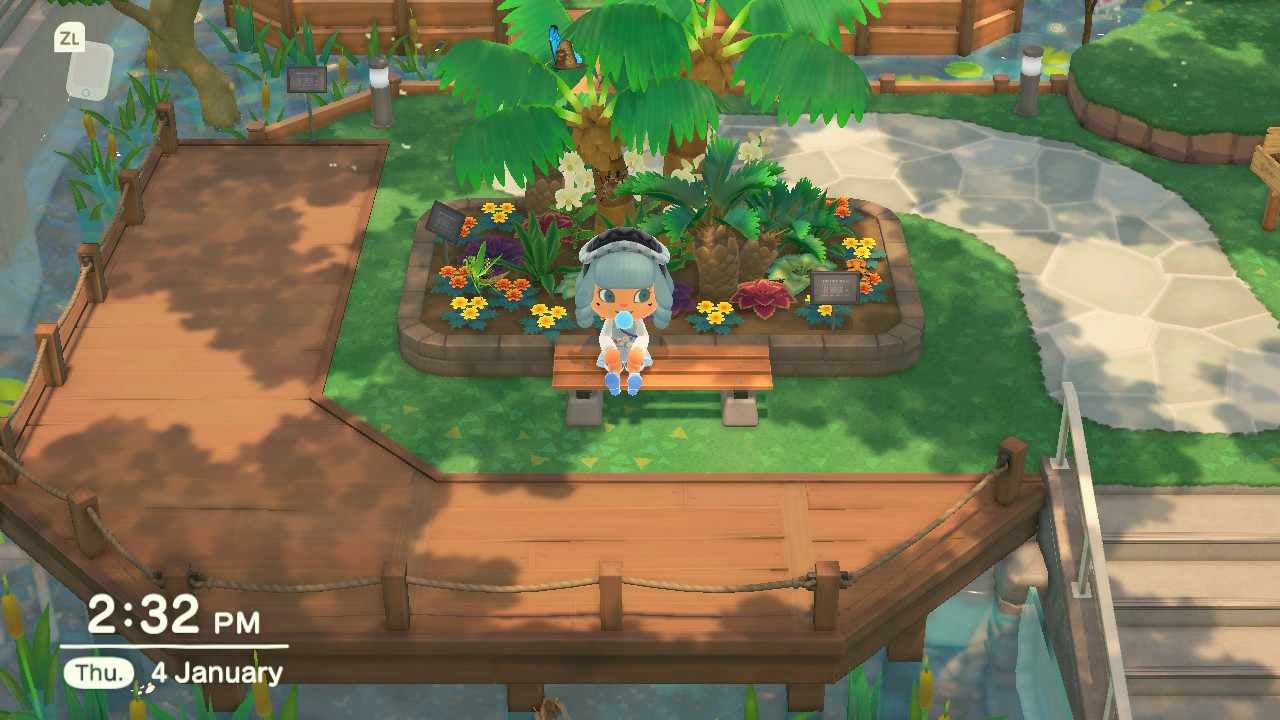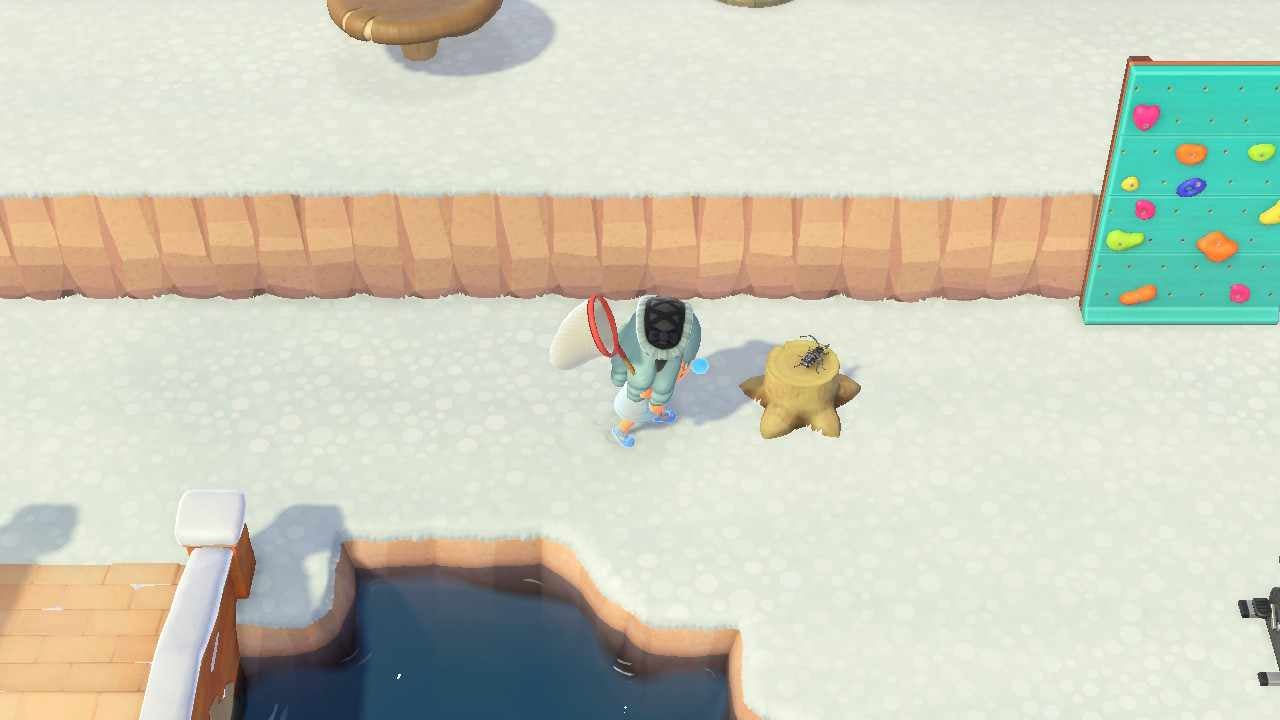![]() Key Takeaway
Key Takeaway
To start catching bugs in Animal Crossing: New Horizons, you’ll need a Net, which can be bought at Nook’s Cranny or crafted using materials like Tree Branches once you’ve got the crafting recipe from Tom Nook. There are 80 different bugs to catch, which can be donated to the Museum or sold as a money-making method.
Bugs can spawn anywhere on your island: on trees, the water’s surface, by flowers, or even on the ground. Each bug has specific time and weather conditions to spawn, with different months for the Northern and Southern Hemisphere.
Dive on a journey beneath leaves and trees in our Animal Crossing: New Horizons Bug guide. From swinging your net to capturing all 80 different creepy critters, we’ve got everything you need to know about becoming the ultimate Animal Crossing bugs collector on your virtual island!
Table Of Contents
About Bugs in Animal Crossing: New Horizons

After catching an insect in your Net, they’ll show up in your Critterpedia: the number one destination for documenting all your catches. This in-game app gives a detailed breakdown of every critter you collect, including their active seasons and where to catch them.
If you want to catch every insect and create your own insectarium, you can donate them to Blathers at the Museum. While this doesn’t yield any rewards, it’s fun to check out all the bugs you’ve ensnared.
Sell excess bugs at Nook’s Cranny for a pretty penny. Or save them for a rainy day and sell them to bug fanatic Flick whenever he visits your island for even more Bells. Like fish in AC: NH, the rarer the insect, the more money you’ll get in return!
How to Catch Bugs in Animal Crossing: New Horizons

To start bug collecting, you’ll first need a Net. You can either craft one yourself or purchase one from the upgraded Nook’s Cranny. Take a look at the table below for every Net available in Animal Crossing: New Horizons, including their durability and how to get them.
| Net Name | Durability | How to Obtain | Crafting Materials (if any) | Buy Price |
|---|---|---|---|---|
| Flimsy Net | 10 uses | Recipe obtained from Tom Nook (first DIY workshop) | 5 Tree Branches | 100 Bells |
| Net | 30 uses | Recipe obtained from Pretty Good Tools Recipes, which costs 3,000 Miles at the Nook Stop in Resident Services | 1 Flimsy Net, 1 Iron Nugget | N/A |
| Outdoorsy Net | 30 uses | Purchased from the cabinet at Nook's Cranny after the first upgrade | N/A | 2,500 Bells |
| Star Net | 30 uses | Purchased from the cabinet at Nook's Cranny after the first upgrade | N/A | 2,500 Bells |
| Colorful Net | 30 uses | Purchased from the cabinet at Nook's Cranny after the first upgrade | N/A | 2,500 Bells |
| Golden Net | 90 uses | Recipe obtained by catching every bug in the game | 1 Net, 1 Gold Nugget | N/A |
Bug Catching Tips
Catching bugs can be extremely tough, especially if you’re heavy-footed! Here are some simple tips to keep in mind before swinging your Net.
- Walk – don’t run! Some insects, being the delicate creatures they are, will flee if you’re running or sprinting around. To maximize your chances of success, carefully walk to get near the insect before attempting to capture them.
- Tiptoe. Having your Net equipped and holding down the “A” button lets you tiptoe near the bug. Aiming and letting go of “A” causes the Net to come crashing down on the unsuspecting critter.
- Learn their patterns. Unlike Fish, Bugs in Animal Crossing: New Horizons have a wider range of patterns and behaviors. Learning what to look out for will increase your success rate, rather than swinging and missing. Missing your net will also cause the bug in question to flee and despawn.
- For example, Grasshoppers hop around on the ground, Scorpions chase after the player, and Beetles chill out on tree stumps.
- Sound = On. Having your in-game sound effects turned up helps you listen out for nearby insects.
- For instance, the chirp of a Grasshopper helps point you in the right direction to capture them.
- Nature and flora are your friends! To attract a wider variety of insects, you should ensure your island has various perch options for insects. This includes Tree Stumps and Flowers to attract bugs like Beetles and Butterflies.
All Bugs in Animal Crossing: New Horizons
There’s a grand total of 80 insects to catch in Animal Crossing: New Horizons, an increase of eight from Animal Crossing: New Leaf. Among the more recent additions include: the Atlas Moth, Blue Weevil Beetle, Common Bluebottle, Damselfly, Giant Water Bug, Giraffe Stag, Madagascan Sunset Moth, Man-Faced Stink Bug, and Paper Kite Butterfly.
Without further ado, here’s a list of all insects in Animal Crossing: New Horizons, divided into where each bug can be found (Flying, Ground, Flowers, Trees, and Other). Start swinging your Net, and you’ll fill in your Critterpedia faster than a Scorpion can sting you!
Flying Bugs

There are 22 different Flying Bugs in Animal Crossing: New Horizons. Just like in real life, Butterflies find their home amongst the colorful flower blooms, so make sure you have plenty planted! Butterflies don’t fly away when you sprint, but watch out for their erratic movements; they can be a tricky catch.
| Bug Name | Where to Catch | Selling Price | Spawn Time | Weather Conditions | Northern Hemipshere | Southern Hemisphere |
|---|---|---|---|---|---|---|
| Mosquito | Flying | 130 Bells | 5 PM - 4 AM | Any (except rain) | June, July, August, September | December, January, February, March |
| Common Butterfly | Flying | 160 Bells | 4 AM - 7 PM | Any (except rain) | All months, except July | All months except January and February |
| Yellow Butterfly | Flying | 160 Bells | 4 AM - 7 PM | Any (except rain) | March, April, May, June, September, October | September, October, November, December, March, April |
| Tiger Butterfly | Flying | 240 Bells | 4 AM - 7 PM | Any (except rain) | March, April, May, June, July, August, September | September, October, November, December, January, February |
| Common Bluebottle | Flying | 300 Bells | 4 AM - 7 PM | Any (except rain) | April, May, June, July, August | October, November, December, January, February |
| Peacock Butterfly | Flying | 2,500 Bells | 4 AM - 7 PM | Any (except rain) | March, April, May, June | September, October, November, December |
| Agrias Butterfly | Flying (near flowers) | 3,000 Bells | 8 AM - 5 PM | Any (except rain) | April, May, June, July, August, September | November, December, January, February, March |
| Paper Kite Butterfly | Flying (near flowers) | 1,000 Bells | 8 AM - 7 PM | Any (except rain) | All months | All months |
| Monarch Butterfly | Flying (near flowers) | 140 Bells | 4 AM - 5 PM | Any (except rain) | September, October, November | March, April, May |
| Emperor Butterfly | Flying (near flowers) | 4,000 Bells | 5 PM - 8 AM | Any (except rain) | All months except April, May, October, November | All months except April, May, October, November |
| Great Purple Emperor | Flying (near flowers) | 3,000 Bells | 4 AM - 7 PM | Any (except rain) | May, June, July, August | November, December, January, February |
| Rajah Brooke's Birdwing | Flying (near flowers) | 2,500 Bells | 8 AM - 5 PM | Any (except rain) | All months except March, October, November | All months except April, May, September |
| Queen Alexandra's Birdwing | Flying (near flowers) | 4,000 Bells | 8 AM - 4 PM | Any (except rain) | May, June, July, August, September | November, December, January, February, March |
| Madagascan Sunset Moth | Flying (near flowers) | 2,500 Bells | 8 AM - 4 PM | Any (except rain) | April, May, June, July, August, September | September, October, November, December, January |
| Honeybee | Flying (near flowers) | 200 Bells | 8 AM - 5 PM | Any (except rain) | March, April, May, June, July | September, October, November, December, January |
| Moth | Flying (near light sources like Resident Services or villager houses) | 130 Bells | 7 PM - 4 AM | Any (except rain) | All months | All months |
| Fly | Flying (near trash or rotten turnips) | 60 Bells | All day | Any | All months | All months |
| Red Dragonfly | Flying (near water) | 180 Bells | 8 AM - 7 PM | Any (except rain) | September, October | March, April |
| Darner Dragonfly | Flying (near water) | 230 Bells | 8 AM - 5 PM | Any (except rain) | April, May, June, July, August, September, October | November, December, January, February, March, April |
| Banded Dragonfly | Flying (near water) | 4,500 Bells | 8 AM - 5 PM | Any (except rain) | May, June, July, August, September, October | November, December, January, February, March, April |
| Damselfly | Flying (near water) | 500 Bells | All day | Any (except rain) | November, December, January, February | May, June, July, August |
| Firefly | Flying (near water) | 300 Bells | 7 PM - 4 AM | Any (except rain) | June | December |
Ground Bugs

There are 10 different types of Ground Bugs, found prowling or hopping around on your island’s soil. Keep your wits about you, especially when seeking out Tarantulas or Scorpions, as these are particularly aggressive and will cause your character to pass out if they attack you.
| Bug Name | Selling Price | Spawn Time | Weather Conditions | Northern Hemisphere | Southern Hemisphere |
|---|---|---|---|---|---|
| Long Locust | 200 Bells | 8 AM - 7 PM | Any | All months except December, January, February, March | All months except June, July, August, September |
| Migratory Locust | 600 Bells | 8 AM - 7 PM | Any | August, September, October, November | February, March, April, May |
| Rice Grasshopper | 400 Bells | 8 AM - 7 PM | Any | August, September, October, November | February, March, April, May |
| Grasshopper | 160 Bells | 8 AM - 5 PM | Any (except rain) | July, August, September | January, February, March |
| Cricket | 130 Bells | 5 PM - 8 AM | Any (except rain) | September, October, November | March, April, May |
| Bell Cricket | 430 Bells | 5 PM - 8 AM | Any (except rain) | September, October | March, April |
| Tiger Beetle | 1,500 Bells | All day | Any (except rain) | All months except November, December, January | All months except May, June, July |
| Earth-boring Dung Beetle | 300 Bells | All day | Any | July, August, September | January, February, March |
| Tarantula | 8,000 Bells | 7 PM - 4 AM | Any | November, December, January, February, March, April | May, June, July, August, September, October |
| Scorpion | 8,000 Bells | 7 PM - 4 AM | Any | May, June, July, August, September, October | November, December, January, February, March, April |
Flower Bugs

The 5 Flower Bugs prefer to make their homes on the floral residents of your island. Make sure to approach with care, as any sudden movements can cause these little critters to despawn and disappear.
| Bug Name | Where to Catch | Selling Price | Spawn Time | Weather Conditions | Northern Hemipshere | Southern Hemisphere |
|---|---|---|---|---|---|---|
| Mantis | On any type of flowers | 430 Bells | 8 AM - 5 PM | Any (except rain) | All months except December, January, February | All months except June, July, August |
| Orchid Mantis | On white flowers | 2,400 Bells | 8 AM - 5 PM | Any (except rain) | All months except December, January, February | All months except June, July, August |
| Ladybug | On any type of flowers | 200 Bells | 8 AM - 5 PM | Any (except rain) | March, April, May, June, October | April, September, October, November, December |
| Stinkbug | On any type of flowers | 120 Bells | All day | Any (except rain) | All months except November, December, January, February | All months except May, June, July, August |
| Man-faced Stinkbug | On any type of flowers | 1,000 Bells | 7 PM - 8 AM | Any (except rain) | All months except November, December, January, February | All months except May, June, July, August |
Tree Bugs

Trees and their Stumps are a bountiful resource in Animal Crossing: New Horizons, both for crafting materials and providing a home for many in-game insects like Beetles, Wasps, and Spiders. There are 31 of these arboreal creatures.
| Bug Name | Where to Catch | Selling Price | Spawn Time | Weather Conditions | Northern Hemisphere | Southern Hemisphere |
|---|---|---|---|---|---|---|
| Walking Leaf | Disguised as a leaf under trees | 600 Bells | All day | Any | July, August, September | January, February, March |
| Blue Weevil Beetle | On palm trees | 800 Bells | All day | Any | July, August | January, February |
| Goliath Beetle | On palm trees | 8,000 Bells | 5 PM - 8 AM | Any | June, July, August, September | December, January, February, March |
| Cyclommatus Stag | On palm trees | 8,000 Bells | 5 PM - 8 AM | Any | July, August | January, February |
| Golden Stag | On palm trees | 12,000 Bells | 5 PM - 8 AM | Any | July, August | January, February |
| Giraffe Stag | On palm trees | 12,000 Bells | 5 PM - 8 AM | Any | July, August | January, February |
| Horned Atlas | On palm trees | 8.000 Bells | 5 PM - 8 AM | Any | July, August | January, February |
| Horned Elephant | On palm trees | 8,000 Bells | 5 PM - 8 AM | Any | July, August | January, February |
| Horned Hercules | On palm trees | 12,000 Bells | 5 PM - 8 AM | Any | July, August | January, February |
| Jewel Beetle | Tree stumps | 2,400 Bells | All day | Any (except rain) | April, May, June, July, August | October, November, December, January, February |
| Violin Beetle | Tree stumps | 450 Bells | All day | Any (except rain) | May, June, October, November | March, April, May, November, December |
| Citrus Long-horned Beetle | Tree stumps | 350 Bells | All day | Any (except rain) | All months | All months |
| Rosalia Batesi Beetle | Tree stumps | 3,000 Bells | All day | Any (except rain) | May, June, July, August, September | November, December, January, February, March |
| Atlas Moth | Trees (any kind) | 3,000 Bells | 7 PM - 4 AM | Any | April, May, June, July, August, September | October, November, December, January, February, March |
| Scarab Beetle | Trees (any kind) | 10,000 Bells | 11 PM - 8 AM | Any | July, August | January, February |
| Drone Beetle | Trees (any kind) | 200 Bells | All day | Any | June, July, August | December, January, February |
| Saw Stag | Trees (any kind) | 2,000 Bells | All day | Any | July, August | January, February |
| Miyama Stag | Trees (any kind) | 1,000 Bells | All day | Any | July, August | January, February |
| Giant Stag | Trees (any kind) | 10,000 Bells | 11 PM - 8 AM | Any | July, August | January, February |
| Rainbow Stag | Trees (any kind) | 6,000 Bells | 7 PM - 8 AM | Any | June, July, August, September | December, January, February, March |
| Horned Dynastid | Trees (any kind) | 1,350 Bells | 7 PM - 8 AM | Any | July, August | January, February |
| Walking Stick | Trees (any kind) | 600 Bells | 4 AM - 8 AM and 5 PM - 7 PM | Any | July, August, September, October, November | January, February, March, April, May |
| Brown Cicada | Trees (Hardwood and Cedar) | 250 Bells | 8 AM - 5 PM | Any | July, August | January, February |
| Robust Cicada | Trees (Hardwood and Cedar) | 300 Bells | 8 AM - 5 PM | Any | July, August | January, February |
| Giant Cicada | Trees (Hardwood and Cedar) | 500 Bells | 8 AM - 5 PM | Any | July, August | January, February |
| Walker Cicada | Trees (Hardwood and Cedar) | 400 Bells | 8 AM - 5 PM | Any | August, September | February, March |
| Evening Cicada | Trees (Hardwood and Cedar) | 550 Bells | 4 AM - 8 AM and 4 PM - 7 PM | Any | July, August | January, February |
| Cicada Shell | Trees (Hardwood and Cedar) | 10 Bells | All day | Any | July, August | January, February |
| Wasp | Shaking trees (Cedar or Hardwood) | 2,500 Bells | All day | Any | All months | All months |
| Spider | Shaking trees | 600 Bells | 7 PM - 8 AM | Any | All months | All months |
| Bagworm | Shaking trees | 600 Bells | All day | Any | All months | All months |
Other Bugs

Aside from the previously mentioned locations, Bugs can spawn in many other locations. In this table, we’ve included the exact location or requirements to get these Bugs to spawn so that you can fill the remainder of your Critterpedia. These last few multi-legged fellows count 12 overall.
| Bug Name | Where to Catch | Selling Price | Spawn Time | Weather Conditions | Northern Hemisphere | Southern Hemisphere |
|---|---|---|---|---|---|---|
| Flea | On villager's heads | 70 Bells | All day | Any | April, May, June, July, August, September, October, November | January, February, March, April, May, September, October, November, December |
| Mole Cricket | Dug from underground | 500 Bells | All day | Any | January, February, March, April, May, November, December | May, June, July, August, September, October, November |
| Ant | On spoiled food left on the ground, like turnips | 80 Bells | All day | Any | All months | All months |
| Snail | On rocks and bushes | 250 Bells | All day | Rain | All months | All months |
| Wharf Roach | On beach rocks | 200 Bells | All day | Any | All months | All months |
| Centipede | From hitting rocks with a shovel | 300 Bells | 4 PM - 11 PM | Any | All months except July and August | All months except January and February |
| Pill Bug | From hitting rocks with a shovel | 250 Bells | 11 PM - 4 PM | Any | All months except July and August | All months except January and February |
| Hermit Crab | Disguised as a shell on the beach | 1,000 Bells | 7 PM - 8 AM | Any | All months | All months |
| Dung Beetle | Pushes around snowballs on the ground | 3,000 Bells | All day | Any | December, January, February | June, July, August |
| Pondskater | On rivers and ponds | 130 Bells | 8 AM - 7 PM | Any | May, June, July, August, September | November, December, January, February, March |
| Diving Beetle | On rivers and ponds | 800 Bells | 8 AM - 7 PM | Any | May, June, July, August, September | November, December, January, February, March |
| Giant Water Bug | On rivers and ponds | 2,000 Bells | 7 PM - 8 AM | Any | April, May, June, July, August, September | October, November, December, January, February, March |
As you swing your virtual Net in the world of Animal Crossing: New Horizons, armed with our valuable knowledge from our Bug guide, you’ll become an experienced Bug Collector in no time at all. If you’ve got a green thumb, try breeding the rare Blue Roses or even Golden Roses to make your island critters even happier.


